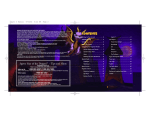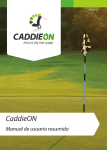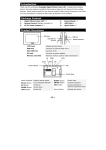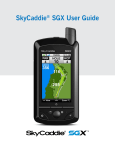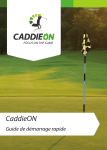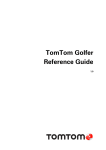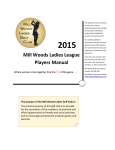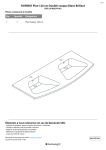Download Golf Course User Manual
Transcript
Golf Course User Manual Basic Maintenance and Etiquette for the Casual Golfer By Eric Morlang Eric’s Hole in One, Inc. No part of this publication may be reproduced or transmitted in any form or by any means. Every effort has been made to ensure the information in this manual is accurate. Different course may provide different tools or advacate different rules, and those rules should be abided above this manual. This manual is intended for reference purposes only. Products mentioned or described in this manual may vary by manufacturer or condition of use. Please only use products in good condition and follow the guidelines provided with these tools, whether given in a separate manual or by the marshal of the golf course they belong to. Published in Canada 2 Version 1.0 Table of Contents Introduction .................................. 5 Who this is for ................................6 How this is organized ......................6 Tips, notes, and cautions .................7 Required tools ................................7 Getting Started .............................. 8 Checking in ....................................9 To book your round ......................... 9 To start your round........................ 10 Playing at the tee box ................... 11 To decide who shoots first .............. 11 To fill in divots .............................. 13 Playing a Hole .............................. 14 Playing from the fairway ................ 15 To play your ball ........................... 16 To correct divots ........................... 17 Playing from hazards .................... 18 3 To drop your ball ........................... 19 To clean a bunker .......................... 20 Finishing a Hole ........................... 21 Getting on and off the green .......... 22 To walk on the green ..................... 23 To exit the green ........................... 23 Playing on the green ..................... 24 To fix ball marks ........................... 25 To mark your ball .......................... 26 Appendix A .................................. 27 Deciding what to wear................... 27 Operating the golf cart .................. 28 Glossary ....................................... 30 Index ........................................... 33 4 1 Introduction Welcome to the Golf Course User Manual. This manual provides you with information on basic golf course maintenance and etiquette for players. Golf is an excellent sport to play casually with friends and also with business associates or co-workers. Proper etiquette maintains a polite and friendly atmosphere, allowing golfers to focus on the pleasures of golf. These pleasures include the beautiful nature the courses are embedded into. To enjoy the natural setting and allow others to do the same, proper maintenance knowledge is a valuable tool. This section includes information about: Who this is for How this is organized Tips, notes, and cautions Required maintenance tools 5 Section 1 Who this is for This user manual is intended for novice and intermediate golfers. You should understand how to play golf and count your score. This manual is designed to be carried in your golf bag at all times. How this is organized This manual is organized into four main sections and a reference section. The sections follow the use of a golf course chronologically. The sections are broken down into topics surrounding typical situations on the golf course. These topics are further broken down into procedures with step-by-step information to complete basic tasks. Notes, tips, and cautions are provided after the procedure. Images are included when necessary to clarify information or procedures. A glossary and index are included in the reference section to clarify golf terms and cross reference material. The basic rules for golf etiquette are also included in the final reference section. 6 Introduction Tips, notes, and cautions You will see the following symbols throughout the user manual: This golf ball is a note symbol which provides important information affecting the procedure. This flag pin is a tip symbol which provides additional hints about performing the procedure effectively. This water hazard is a caution symbol which warns you of misuse and safety concerns. Required tools Provided on the course: In your bag: Tee box sod Rake Divot corrector Ball marker 7 2 Getting Started The following section explains the basic etiquette and maintenance procedures of starting your round on the golf course. This follows from booking your round to playing at the tee box. Before you can begin playing on the golf course, you must book your round and speak to the appropriate officials. This gives you time to prepare for your round, and also offers an opportunity to speak with seasoned veterans of the golf course. Playing at the tee box provides a neutral start for all golfers, so maintenance is important to uphold a fresh start. This section includes information about: 8 Booking your round Playing at the tee box Getting Started Checking in Checking in is required every time you play a round on the golf course, even if you are a member. You must book your tee off time and start your round with course officials. This gives you time to consult the marshals about the weather and the conditions on the course. You will then be able to start your round. To book your round 1. Call the golf course club house during course hours A club house official will answer the phone 2. Explain you are looking to book a round 3. The official will ask you to confirm your name 4. Confirm your first and last name 5. Select a time and number of players Your round has been booked You should book your round no less than 2 hours in advance. 9 Section 2 To start your round 1. Speak to the club house official They will ask you to pay your green fee 2. Pay your green fee They will provide your tee off ticket 3. Approach the first hole 4. Once you have arrived at the first hole, show the marshal your tee off ticket The marshal will initial the ticket 5. Once the marshal says you are clear, play your first shot While members do not have to pay green fees, they must still check in at the club house. 10 Getting Started Playing at the tee box Golfers begin their round and each hole at the tee box. At the tee box, you may tee up your ball for greater loft. However, this also creates deeper divots. Filling divots on the tee box with tee box sod ensures golfers can have a pleasant start. Knowing who shoots first maintains a polite atmosphere. Once all players have taken their shots, you may continue onto the fairway. Figure 1 Tee Box 11 Section 2 To decide who shoots first 1. Grab a tee 2. Have all players stand in a circle 3. Once you have a circle, toss the tee in the middle Whomever the tee points at will shoot first 4. Repeat steps 1-3 until you have a complete order For the following holes, allow the players with the lowest score on the previous hole to shoot first. 12 Getting Started To fill in divots 1. If the tee is still in the divot, remove it 2. Scoop sod out of the container with the spade provided 3. Dump sod into the divot 4. Spread the sod evenly in the divot (see Figure 2) 5. Replace the spade in the container The dirt will be covered with green sod Figure 2 Tee Box Divot Filled In 13 3 Section 3 Playing a Hole The following section explains the basic etiquette and maintenance procedures of playing a hole on the golf course. This involves the bulk of the hole between the tee box and the green. In between the tee box and the fairway, you can play your ball, correct your divots, move your ball from unplayable hazards, and clean bunkers you have hit from. These procedures maintain the rate of play and the appearance of the course. Performing these procedures also provides you with time to assess your previous shots and prepare for the following ones. This section includes information about: 14 Playing from the fairway Playing from hazards Getting Started Playing from the fairway Fairways provide a clear direction to the hole with neatly cut grass to play balls from. Keeping a neat fairway maintains the advantage of playing onto it from the tee box. You must know when to play your ball and how to clean up after your shot to keep these fairways neat. The player furthest from the hole plays their ball first. Once all players have reached the green, you may finish the hole. Figure 3 Fairway 15 Section 3 To play your ball 1. Ensure other players in your group know you are playing your ball 2. Strike your ball There will be a divot where your ball was 3. Fix your divot (see Figure 4) 4. Approach the next ball furthest from the green If your ball veers into another fairway, yell “fore!” to warn other players. Figure 4 Divot 16 Playing a Hole To correct divots 1. Find the patch that came out of the fairway 2. Replace the patch to the divot (see Figure 5) The earth will be covered with grass 3. Step on the patch If the patch is in pieces, fill in the divot as best you can. Figure 5 Correcting a Divot 17 Section 3 Playing from hazards The rough and other hazards lie alongside the fairway, providing a pleasant challenge to the course. Understanding the etiquette of getting your ball out of hazards upholds your rate of play. You must also understand how to clean these hazards, such as raking bunkers if you play out of them. Cleaning these hazards leaves them as a pleasant challenge for the next players on the course. Figure 6 Bunker Hazard 18 Playing a Hole To drop your ball 1. Lay a club down perpendicular to your ball so that it is pointing toward a playable area 2. Flip the club lengthwise to extend the distance from your ball (see Figure 7) 3. Pick up your ball 4. Place your ball at the furthest end of your club You are allowed to take a free drop from cart paths and man-made hazards (such as divots or cart wheel gouges) Figure 7 Dropping a Ball 19 Section 3 To clean a bunker 1. Walk in a straight line toward your ball 2. Play your shot A divot will be left in the sand 3. After following your initial path out of the bunker, grab a rake provided at the edge of the bunker 4. Follow your path back to the divot 5. Rake the sand evenly over the divot 6. Rake your footprints lightly as you exit the bunker Play all your shots to get out of the bunker before raking. Figure 8 Cleaning a Bunker 20 4 Finishing a Hole The following section explains the basic etiquette and maintenance procedures of finishing a hole on the golf course. This involves actions from getting on the green up to exiting the green. At this stage, you can walk on the green, fix your ball mark, mark your ball, and exit the green. These procedures maintain the smooth surface of the green and uphold the rate of play. These procedures also provide you with an opportunity to assess your final puts to complete the hole. By keeping the green smooth, you can assess the natural hills and contours to reduce the number of putts you make. A well maintained green upholds the intended challenges of its design. This section includes information about: Getting on and off the green Playing on the green 21 Section 4 Getting on and off the green You must wait until all players have shot their balls onto the green before you can begin to put. Following the etiquette procedures of walking on and exiting the green maintains a polite atmosphere to golf in. These procedures also uphold the rate of play expected on the golf course. Figure 9 Green 22 Finishing a Hole To walk on the green 1. Wait until all players have shot their balls onto the green 2. Place your bag off the edge of the green 3. Walk onto the green 4. Remove the flag pin 5. Place the flag pin at the edge of the green 6. Make your putts Do not walk between anyone’s ball and the hole; this can disrupt the natural contours of the green. To exit the green 1. Replace the flag pin 2. Wave on the players behind you to let them know you are done 3. Exit the green 4. Continue to the next hole Record your score at the next hole to uphold the rate of play. 23 Section 4 Playing on the green The green is a very soft turf of short cut grass, providing a smooth surface for golfers to putt on. Natural contours provide the challenge for golfers. The green is very impressionable, so balls landing on the green leave marks that disturb the natural contours. Proper maintenance with divot correctors keeps the challenge fair for yourself and other golfers. Proper etiquette with ball markers establishes the rate of play and gives you time to assess your putts. Figure 10 Preparing to Play on the Green 24 Finishing a Hole To fix ball marks 1. Find your ball mark 2. Insert the divot corrector spikes next to the ball mark (see Figure 11) The divot corrector should sit at an obtuse angle from the ball mark 3. Gently tilt the divot corrector towards a 90 degree angle with the ball mark 4. Remove the divot corrector 5. Repeat steps 2-4 to form a semi-circle around the ball mark The ball mark should be lifted evenly 6. Press on the ball mark with your putter The ball mark will be pressed flat Figure 11 Fixing a Ball Mark 25 Section 4 To mark your ball 1. Place the marker gently behind the ball (see Figure 12) 2. Pick up the ball 3. Press the marker flat 4. Clean your ball with a towel 5. Replace your ball to its proper position 6. Remove the marker Use a straight line on your ball to replace it pointing in the direction you want to putt. Figure 12 Marking a Ball 26 A A Appendix Appendix A This section includes reference information about what you can where on the golf course. It also includes information on the rules of driving a golf cart. Deciding what to wear Golf attire should be business casual. Most golfers participate in company tournaments; it is a great way to socialize with co-workers and friends in a natural setting. This is reflected in the attire required on the golf course. The following attire is acceptable: Collared shirt Dress pants Dress shorts (above the knee) Skit (for women) Golf shoes (white or black running shoes acceptable) Hat (typically baseball cap) 27 Appendix A Some courses do not allow hard spikes on golf shoes. Soft spikes are preferable and can be worn into the club house as well. Figure 13 Golf Attire Operating the golf cart Golf carts can carry two golfers. Straps at the back of the carts allow clubs to be tied down. Golf carts can increase your rate of play and help you traverse the course more comfortably, saving energy for your golf swing. 28 Appendix A When operating a golf cart, follow these rules: Follow the 90 degree rule (see Figure 14) Obey “Cart Path Only” holes (they will be marked with a sign at the beginning of the hole) Do not drive the cart within 20 yards of the green Do not drive the cart at excessive speeds You must be at least 16 years of age to operate a golf cart. Figure 14 90 Degree Rule 29 G Glossary ball marker A thin, plastic, circular disc the size of a quarter used to indicate where your ball is on the green. ball mark A deep imprint left in the green after a ball lands. bunker A pit designed for the course filled with fine sand located along the edges of fairways and greens. divot An area of turf cut out of the ground where a golf club has been swung. divot corrector A small tool with two spikes and a grip for the thumb and forefinger. drop zone A patch of fairway for players to drop their ball after losing it in a forest or water hazard. They are typically designated with painted white lines. etiquette A code of behaviour that follows social norms and expectations. 30 Glossary fairway A track of neatly cut grass that guides players from the tee box to the green. flag pin A thin flag standing two meters high, which indicates the hole on the green. fore! An exclamation made to warn other players of a golf ball flying off course. green Very neatly trimmed turf with hills and contours surrounding the hole. green fee The cost of playing the 18 holes at the golf course. golf shoes (hard spikes) Dress shoes with metal spikes to provide grip on grass. golf shoes (soft spikes) Dress shoes with rubber spikes to provide grip on grass. hazards Terrain placed on the golf course that golfers cannot play their balls from easily, if at all (e.g. trees, water, bunkers). marshal An employee of the golf course that greets golfers on the first hole. 31 Glossary maintenance Repair and operations for care and upkeep. members Golfers that have paid to join the country club to use the course throughout the season. rake A tool with a long shat and a comb of spike to spread sand. rate of play Staying just behind the group in front of you, rather than just ahead of the group behind you. rough Thick grass off the sides of the fairway and the green. tee A small spike players push into the tee box to hold their ball for the first shot of the hole. tee box An area designated for players to begin a hole. tee box sod A brightly coloured soil provided on tee boxes that supports the growth of grass. 32 I Index B ball mark, 21, 25, 30 ball marker, 7 book booking, 8, 9 C checking in, 9 correcting your divot, 17 D divot, 7, 13, 16, 17, 20, 24, 25, 30 driving the golf cart, 28 drop zone, 30 F fairway, 11, 14, 15, 16, 17, 18, 30, 31, 32 filling in a divot, 13 finishing a hole, 21 fixing ball marks, 25 flag pin, 7, 23, 31 fore, 16, 31 G golf attire, 27 green fee, 10, 31 H hazards, 14, 18, 19, 31 33 Index M marking your ball, 26 marshal, 10, 31 members, 10, 32 moving your ball, 19 P playing a hole, 14 playing from hazards, 18 playing from the fairway, 15 playing your shot, 16 putting on the green, 24 R rake, 7, 20 raking a bunker, 20 rate of play, 14, 18, 21, 22, 23, 24, 28, 32 required tools, 7 34 rough, 18, 32 S shooting first, 12 sod, 7, 11, 13, 32 starting your round, 10 T tee, 8, 9, 10, 11, 12, 13, 14, 15, 31, 32 tee box, 8, 11, 14, 15, 31, 32 U using a divot corrector, 25 W walking off the green, 23 walking on the green, 23



































